Lenovo Yoga 9i review: A worthy flagship?


This is the Yoga 9i and it is Lenovo’s newest flagship notebook. That's puzzling because Lenovo's other notebooks like the Yoga Slim 7 Carbon already seems pretty high-end to me.
So how does the Yoga 9i differentiate itself? Generally speaking, it’s nicer. Apart from top-end specs, it has a more upmarket design and feel, and extra features. But is it worth it? Or should you stick with something cheaper? Let's find out.
The Yoga 9i doesn’t look and feel like any other notebook mainly because it has highly polished and rounded sides. This reminds me of the iPhone 11 Pro. According to Lenovo, the sides are the result of a 10-step process that requires precision CNC milling, sandblasting, anodisation, and then polishing.
A small notch near the top of the notebook makes it easier to lift the display and shows Lenovo’s attention to detail. There are two colour options to choose from: Oatmeal which is a sort of champagne-like gold, and Storm Grey which is a mix of black and grey, like Space Grey. The unit I received is Oatmeal.

To ensure the notebook feels like a luxury device, Lenovo has decided to go with an all-aluminium chassis. This contrasts with the Yoga Slim 7 Carbon which uses a combination of magnesium alloy and carbon fibre.
While aluminium looks and feels more expensive, the obvious downside is that it weighs more. While the Yoga Slim 7 Carbon was only a smidge over 1kg, the Yoga 9i is a more portly 1.4kg. Is it cumbersome? No, of course not. But the extra heft is noticeable.
The Yoga 9i is a convertible notebook. This means the hinge lets you fold the display onto itself, allowing you to use the device as a tablet.
I don’t find this particularly useful because it’s thick and heavy for a tablet. I suppose it could be handy if you want to unwind on your sofa or bed. You could also fold it halfway and use it in a “tent” mode. This can be useful for watching videos at your desk or on a flight.
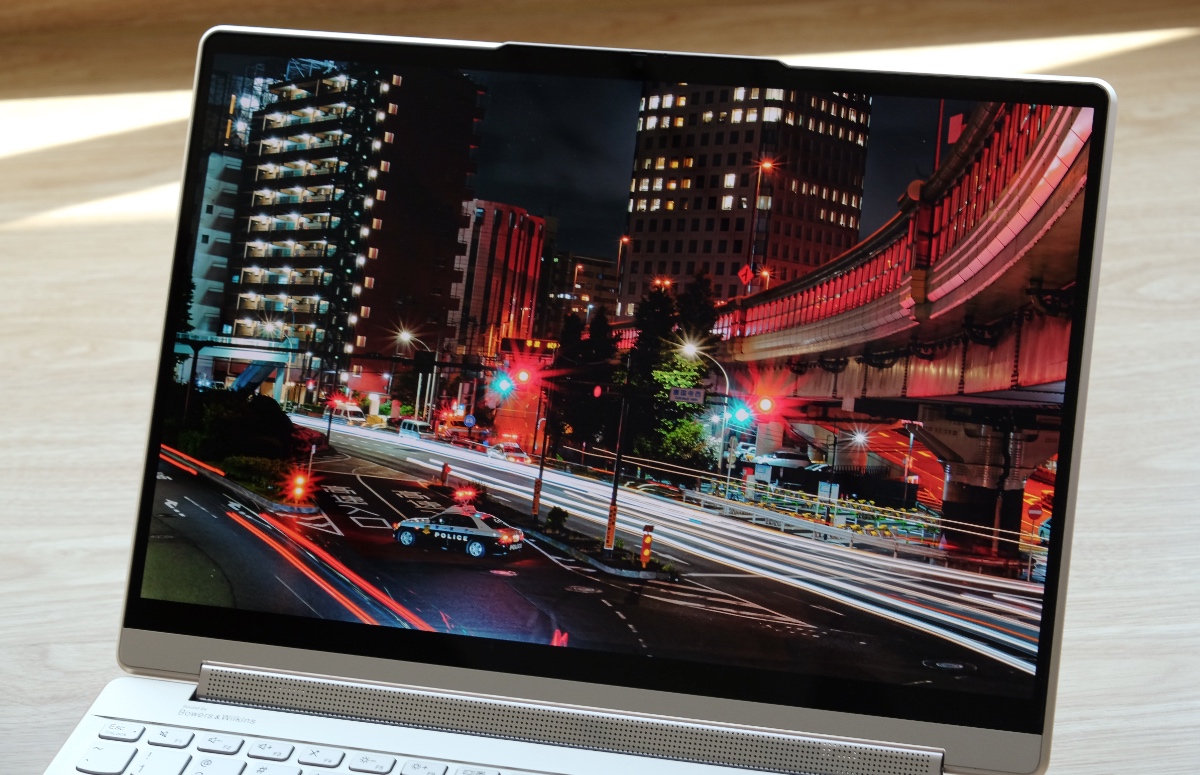
Like many new ultraportable notebooks these days, the Yoga 9i features a cutting-edge OLED display. It’s 14 inches large, has a resolution of 2880 x 1800 pixels, an above-average refresh rate of 90Hz, and supports 100 per cent of the DCI-P3 colour space.
It also meets VESA’s DisplayHDR500 True Black standards. These are impressive specifications and thankfully the Yoga 9i’s display lives up to them. It’s a fantastic display with vivid colours, amazing contrast, and the deep inky kind of blacks that only OLED displays can conjure.
ALSO READ: Lenovo's new Yoga Slim 7 Pro X notebooks are thin and light but have discrete graphics
It’s a very high-end display. For more demanding users, a 4K OLED option is also available. And if you want to save some money, you can also opt for a Full-HD display that has a traditional LCD panel.
Equally high-end are the system specifications. The Yoga 9i features Intel’s newest 12th generation Alder Lake processors. The unit I’m testing got a Core i7-1260P processor with 16GB of LPDDR5 memory and a 512GB PCIe 4.0 SSD. A Core i5 option is also available and you can also equip your Yoga 9i with a larger 1TB SSD.
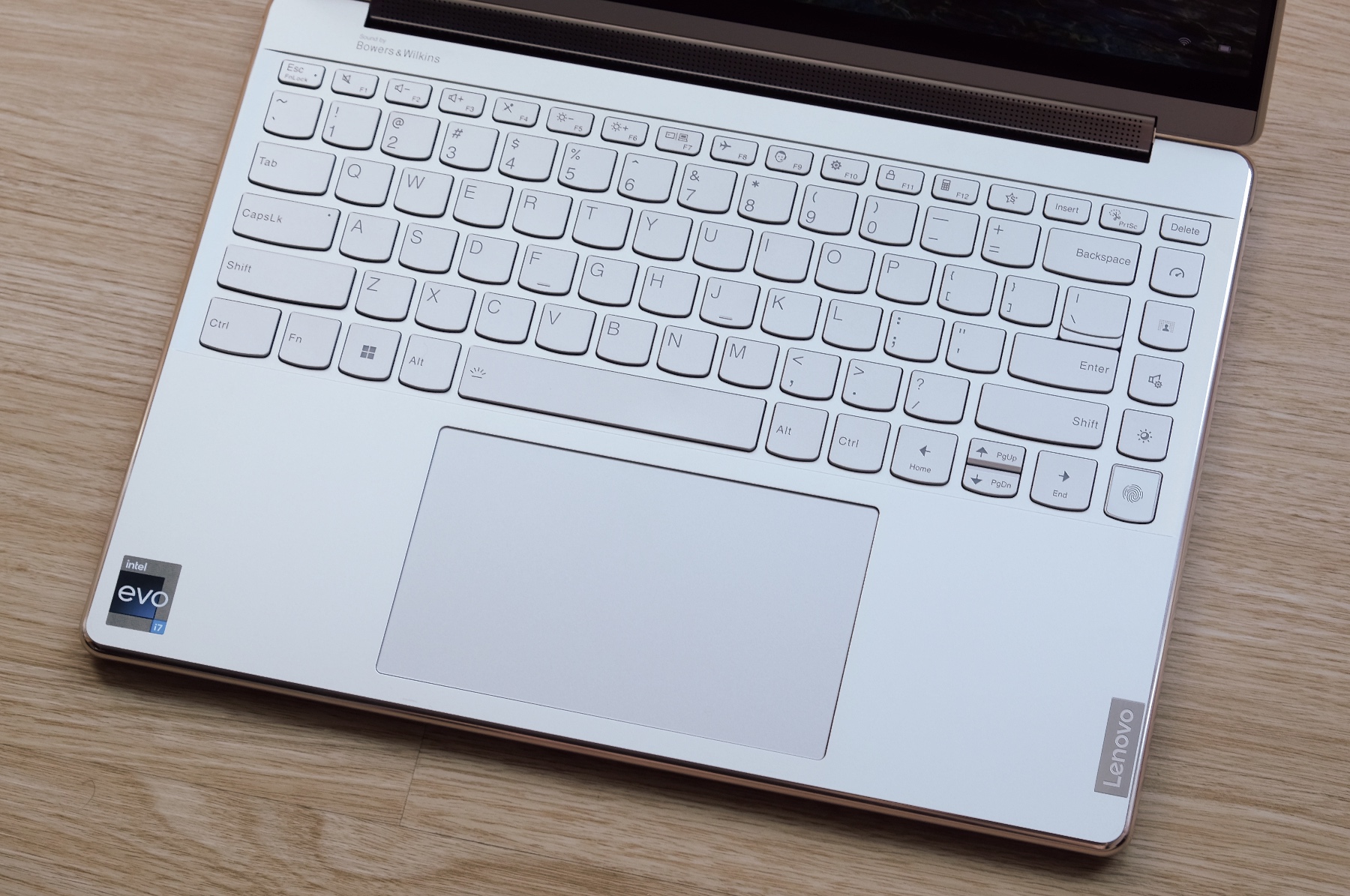
The ports on this notebook are fairly good. You get two USB-C Thunderbolt 4 ports, and on top of that, two USB 3.2 Gen 2 ports – one USB-A and one USB-C. This should allow you to connect to just about any peripheral and accessory. There’s also a 3.5mm audio combo jack. Unfortunately, there’s no memory card slot reader.
The keyboard and trackpad are also excellent. The trackpad is a delight mainly because it is extremely big – it measures a whopping 13.5cm by 8cm. It’s also smooth to touch, accurate, and responsive. I can’t fault the keyboard either.
The layout is sensible and there’s a column of shortcut keys that enables features like performance modes and switches the system between dark and light modes. The keyboard also has a built-in fingerprint scanner for quick logins, though the Yoga 9i also has an IR camera that supports facial recognition logins.
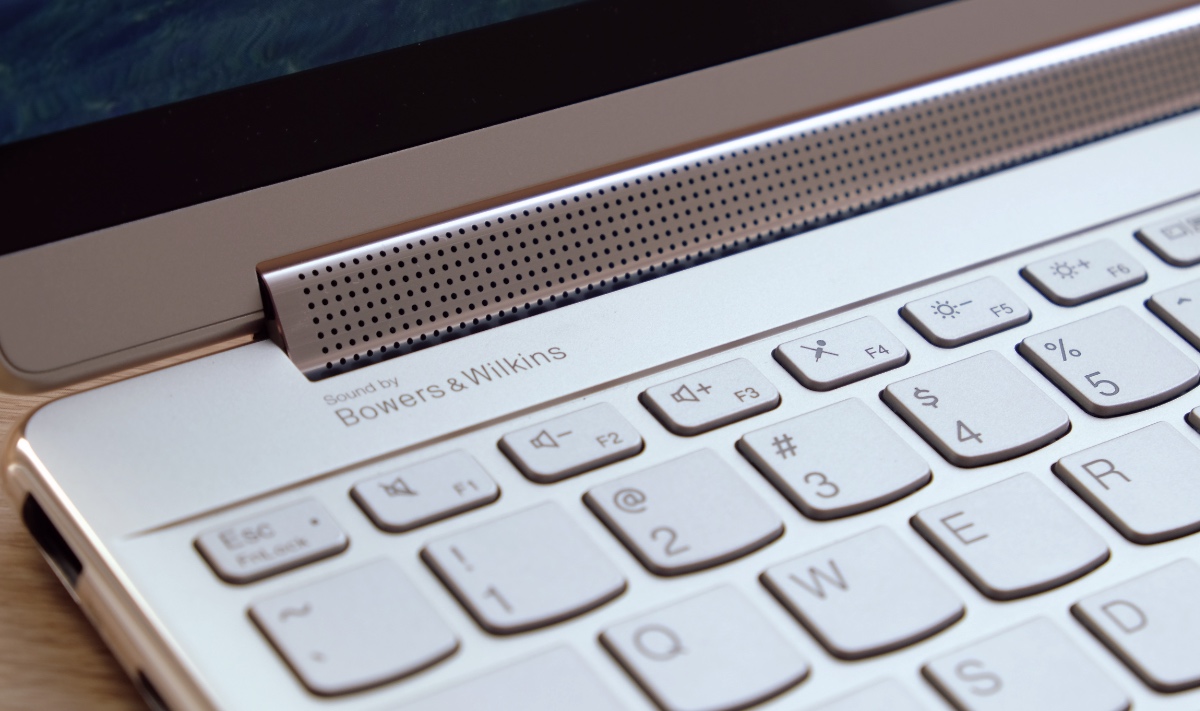
Another feature worth mentioning is the speakers. According to Lenovo and to the best of our knowledge, this is the first time we’ve seen Bowers & Wilkins-branded speakers in a notebook. They are certainly quite good, easily above average.
It’s a dual woofer and dual tweeter setup and their best qualities are clarity, volume, and spaciousness. They get loud and even at high volumes, there’s little distortion. Bass is present in significant quantities but they lack control and therefore sound quite bloated. I think Apple's MacBooks sound better.
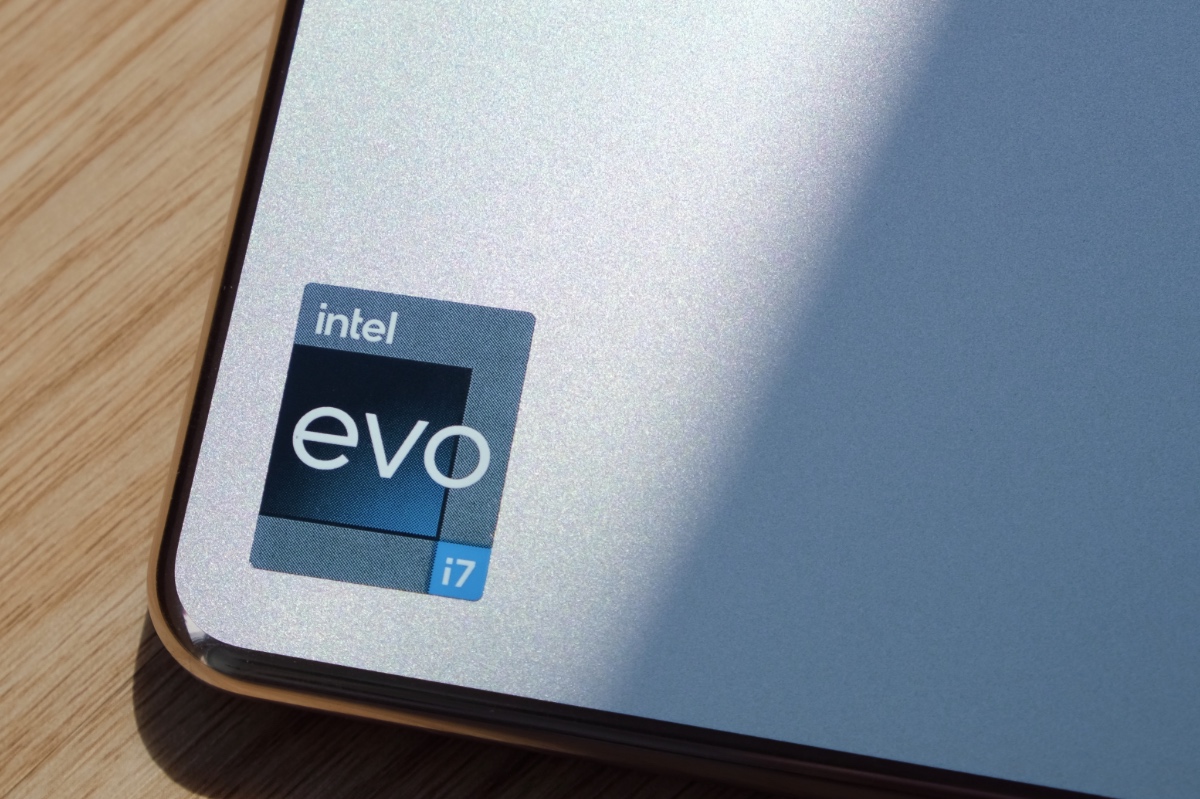
The Yoga 9i is powered by Intel’s newest 12th Gen Alder Lake processors. This is a big change for Intel because it features a big-core + little-core implementation. In this particular unit, we have a Core i7-1260P processor paired with 16GB of LPDDR5 memory and a fast 512GB PCIe 4.0 SSD.
There is no discrete graphics so we are still relying on the chip's integrated Intel Iris Xe GPU. Here’s how it stacks up against other ultraportable notebooks.
Intel’s latest processor certainly delivers performance gains. Compared to notebooks like the HP Spectre x360 and Surface Pro 8 which are powered by the older 11th Gen Ice Lake, the Yoga 9i and its Core i7-1260P racked up significantly higher performance figures, particularly in CPU-intensive benchmarks like Cinebench and Geekbench 5.
And thanks to its speedy PCIe 4.0 SSD, its general computing scores on PCMark 10 were good too. In the real world and in everyday use, however, the differences are less obvious. One more thing to note is that the notebooks gets really warm when taxed and I suspect that's partly due to its all-metal construction.


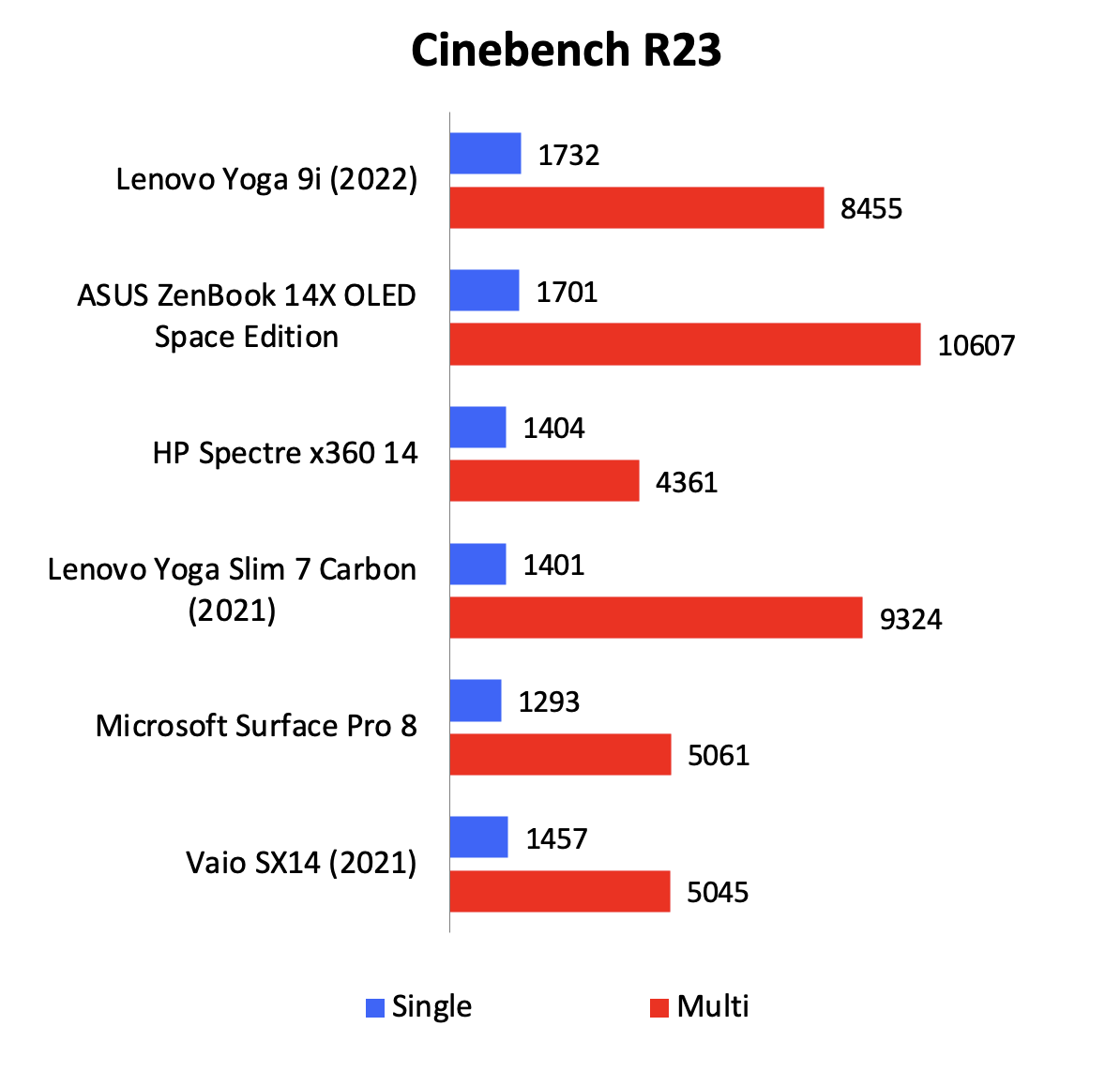

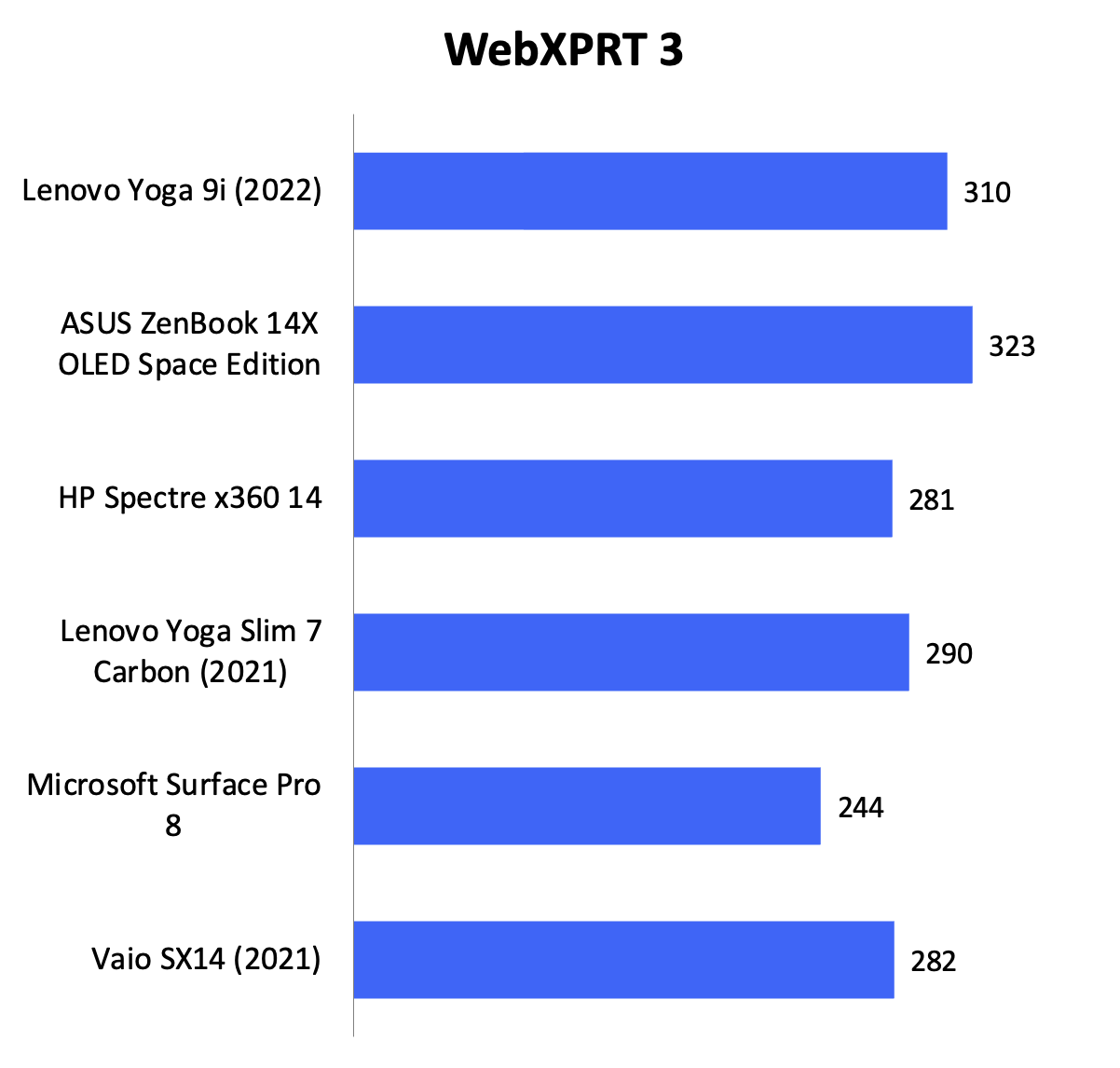
Because the Yoga 9i relies on Intel’s integrated Iris Xe graphics, graphics performance was average at best and wasn’t any better than the notebooks powered by older 11th Gen Ice Lake processors.
Here, the Yoga Slim 7 Carbon which has discrete graphics, albeit in the form of the very basic NVIDIA GeForce MX450, has a slight advantage.

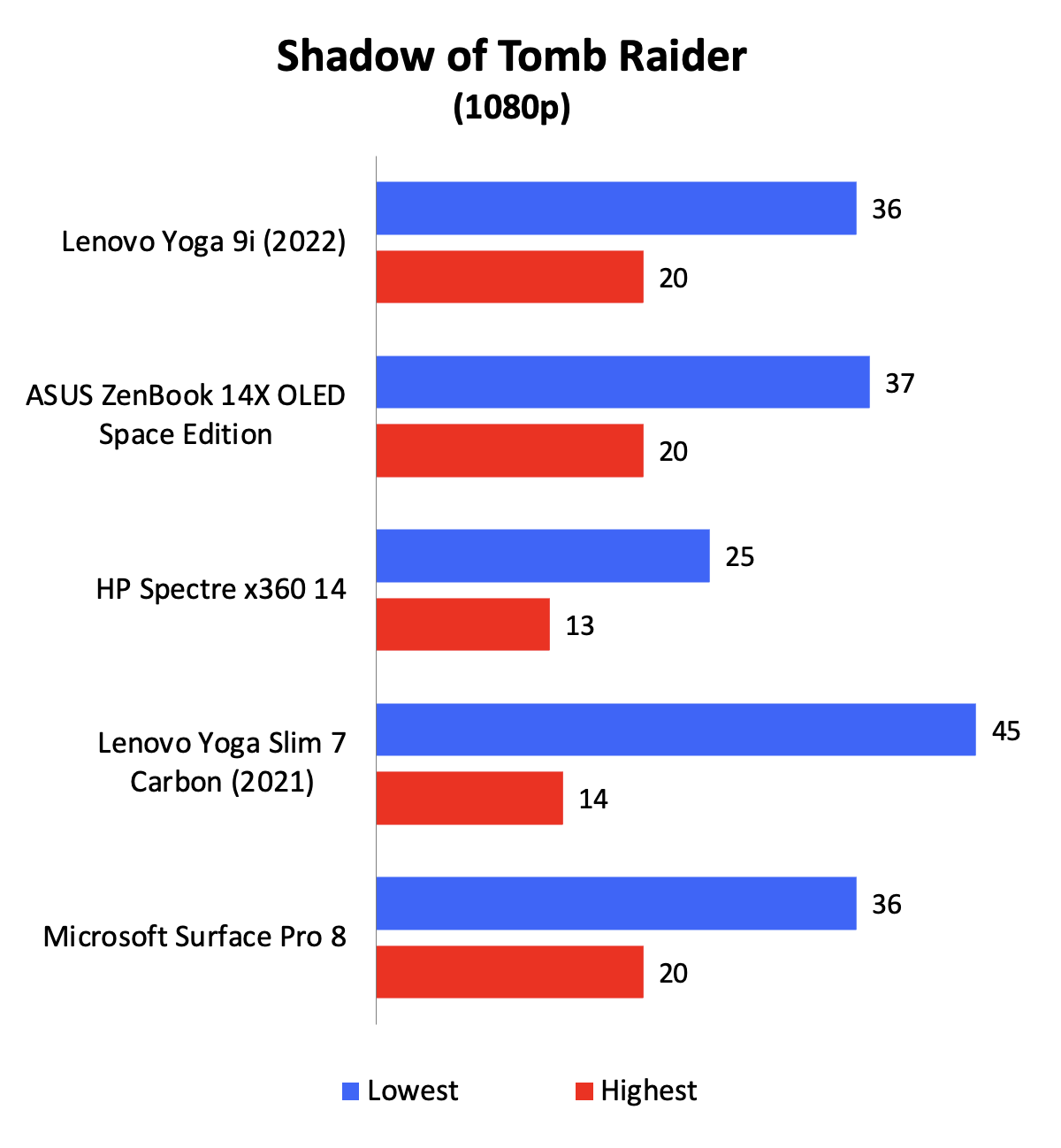

With its 75Wh capacity battery, the Yoga 9i has one of the largest batteries in its class. Battery life was therefore rather decent, despite the bright, high-resolution display. On the Modern Office workload, it lasted 445 minutes or 7 hours and 25 minutes.
That puts in in the middle of the pack. That said, power consumption figures were actually quite high. On the Modern Office workload, it was the only other notebook to go above 10W.
Likewise, on the more intensive Gaming workload, it was the only other notebook to breach the 30W mark. If not for its large battery, its battery life showing would have been a lot poorer.


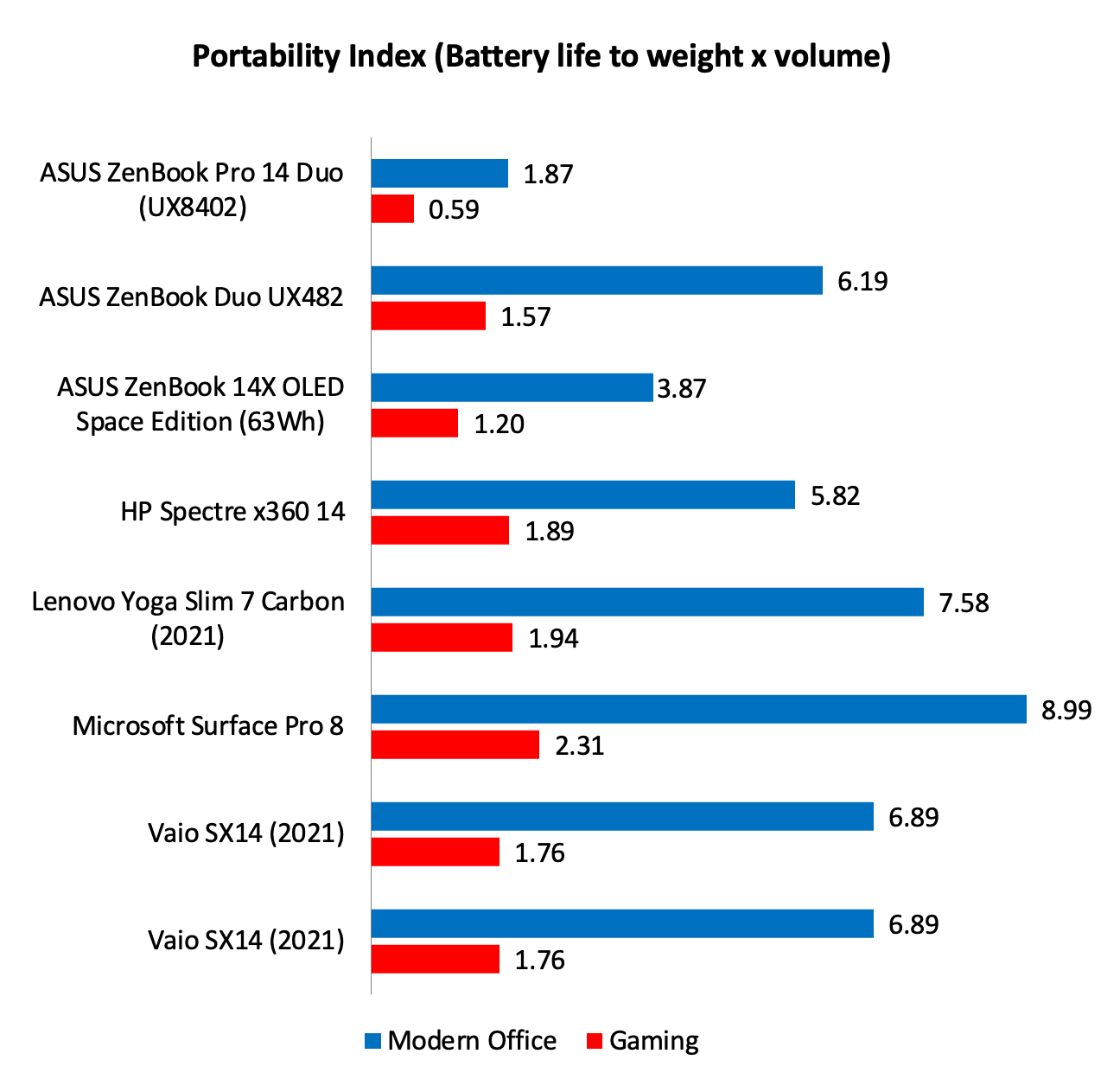
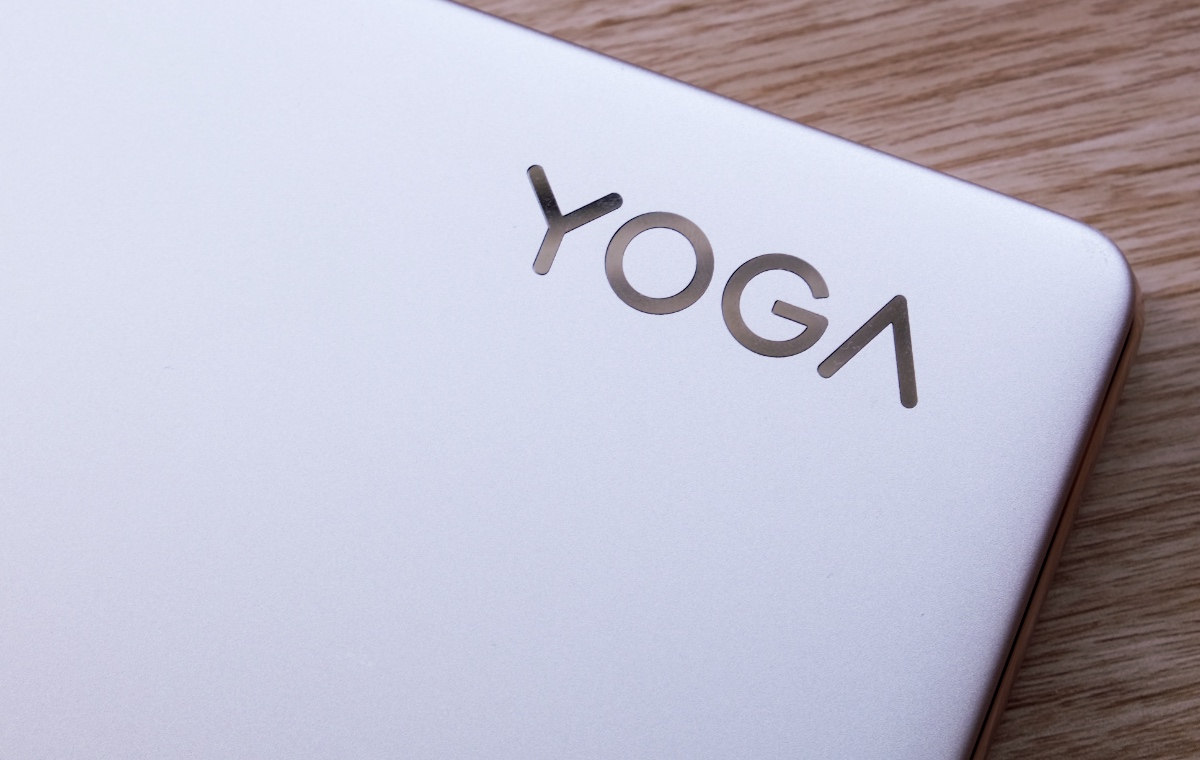
Judged solely by its design and features, the Yoga 9i is a worthy flagship notebook. Build quality is very high, and it looks and feels like an expensive object.
The specifications are beyond reproach too. You get Intel’s latest and greatest 12th-Gen processors, a good amount of memory, and very fast PCIe 4.0 SSD storage. The OLED display is fantastic and portability is decent too – battery life is good and it isn’t too heavy. The speakers are above average and the port selection is good.
ALSO READ: Lenovo unveils new flagship Yoga 9i notebook with Intel Alder Lake processors
Things start to look bad when you take prices into account. According to Lenovo, prices of the Yoga 9i will start at $2,799. That gets you a Yoga 9i with a Core i7 processor, 16GB of memory, 1TB SSD, and a higher resolution 4K OLED display. And indeed, that's the price I found on their Lazada flagship store.
However, I was able to find the Yoga 9i for less on their website. Here, $2,449 gets you one with a Core i5 processor, 16GB of memory, a 512GB SSD, and a 4K OLED display. Regardless, even the most affordable Yoga 9i costs a lot more than the most affordable Yoga Slim 7 Carbon. The Yoga Slim 7 Carbon starts at S$1,699, which means you are looking at a premium of S$750.
Here are the prices of the Yoga 9i that I found on their website:
So is it worth the premium? I’m not sure it does. The Yoga Slim 7 Carbon also has an OLED display and is just as fast, if not faster, than the Yoga 9i. Not only that, it’s lighter and has superior battery life.
Granted, it doesn’t look or feel as nice, the speakers don’t sound as good, and it doesn’t have Thunderbolt 4 ports. But, it offers over 90 per cent of the experience for a lot less.
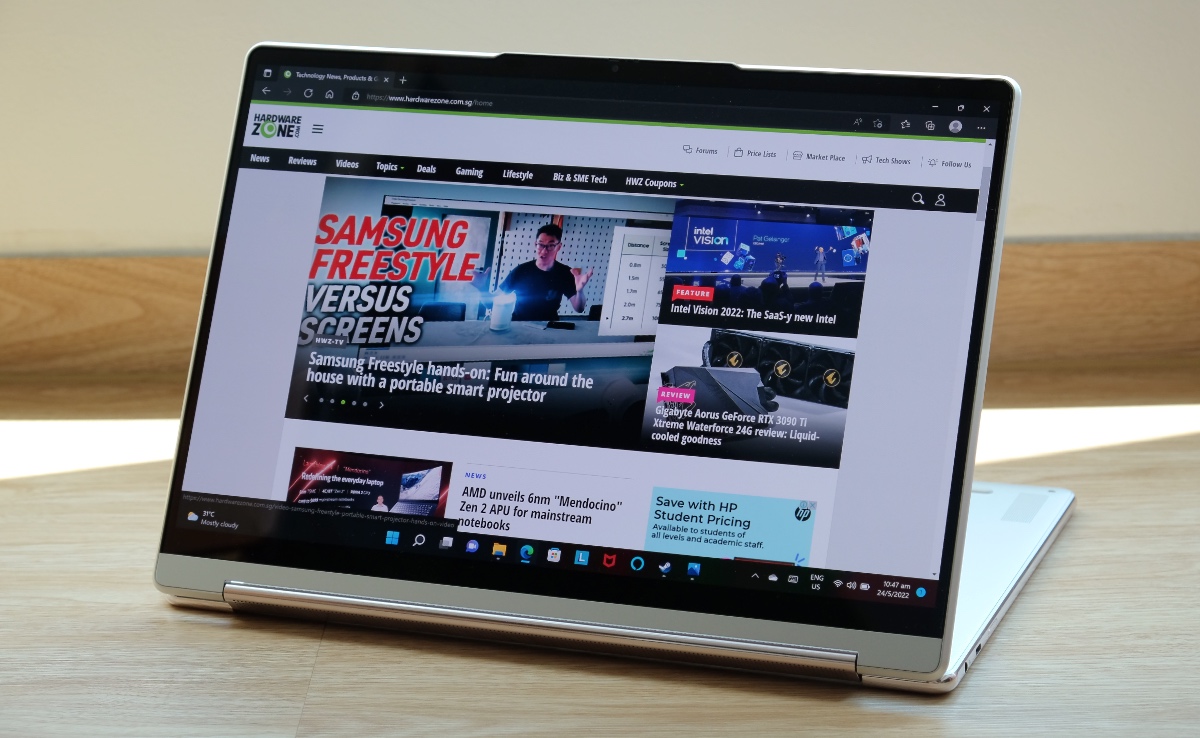
Though it must be said that the Yoga 9i does look more attractive if you compare it against other premium flagship notebooks like the HP Spectre x360 and Dell XPS 13 Plus.
In many ways, the Yoga 9i reminds me of the dichotomy between a regular car and la uxury car. Both will get you where you need to go, but the luxury car will probably do it in greater comfort and style. And how much is that worth to you is up to you to decide.
Me? I’m only paying more for a notebook if its appreciably more powerful and faster. So between the Yoga 9i and Yoga Slim 7 Carbon, I’m taking the latter. It’s not the Tech Awards winner of our Best Ultraportable Notebook category for nothing, you know?
This article was first published in Hardware Zone.